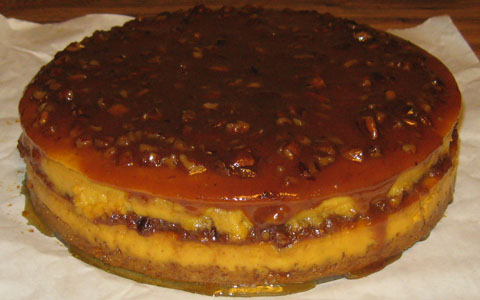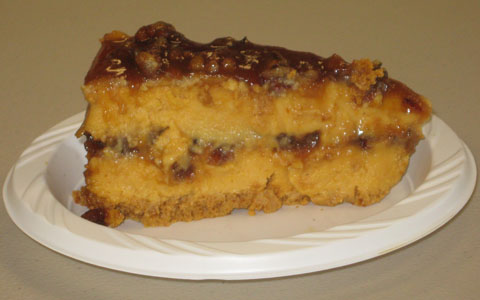|
|
 |
Baked Pumpkin Pecan Cheesecake—Prototype 1:
2-to-1 Blend of Yogurt Cheese and Cottage Cheese:
Prepare ahead of time 2 pounds of yogurt cheese, derived from two 32-ounce
containers of nonfat yogurt. If the resulting yogurt cheese falls below 32
ounces, add back enough of the whey (that was strained out from the yogurt) to
make up the difference. To this yogurt cheese combine 16 ounces (1 pint) of
whipped, lowfat cottage cheese.
Crust:
2 oz. melted, white chocolate
4 oz. pumpkin butter (such as from Trader Joe's)
2 tablespoons granulated sugar
2 tablespoons brown sugar
1/2 teaspoon vanilla
8 oz. (1 cup) 2-to-1 blend of yogurt cheese and cottage cheese (see above)
2 oz. All-Bran, ground up
Pour this crust mixture into pan (9 to 9 1/2 inches) and pre-bake without tub at
300 degrees for 10 minutes, then cool enough to comfortably touch at least the
pan's upper sidewall. Carefully wrap the pan in heavy foil afterwards
(do not wrap it earlier—otherwise, this increases leakage
risks).
Batter:
4 tablespoons melted or softened butter
1 cup granulated sugar
14 oz. pumpkin butter
1/4 cup all-purpose flour
3 tablespoons arrowroot
5 cups (40 oz.) 2-to-1 blend of yogurt cheese and cottage cheese (see above)
2 teaspoons vanilla
4 eggs
Carefully pour about half of this batter on top of the crust. Bake in tub at 325
degrees for 40 minutes (if using a 9 1/2" pan). During this phase of the
baking, prepare the pecan filling for this cheesecake.
Pecan Filling:
2 eggs
1 tablespoon granulated sugar
2 tablespoons all-purpose flour
(Tip: blend these three above ingredients first, before adding the other ones
below.)
2 cups corn syrup
1 teaspoon vanilla
1/4 teaspoon salt
4 oz. chopped pecans (about 1 cup, after chopping)
Combine all these ingredients in a saucepan before heating. Stir constantly
over a roughly medium heat (not high—otherwise the mixture can
easily leave a sticky, burnt residue on the bottom of the pan), bringing the
mixture to a mild boil. Stir and cook carefully for about another 5 minutes,
then remove from heat. Let this mixture sit until it is time to add it to the
cheesecake (at which point the filling should still be at least warm enough that
it spreads very easily).
After the initial 40 minutes of baking, remove the pan-and-tub assembly from the
oven and carefully add just enough of the pecan filling to coat the pumpkin
batter's surface (close to half of the filling—set aside the rest of it for
later, as described below). Next, return the pan-and-tub assembly to the oven
and resume baking at 325 degrees for another 20 minutes.
Afterwards, take this assembly out of the oven and very carefully scoop the
remaining pumpkin batter on top. Then return all this to the oven, with the
temperature reduced to 300 degrees, and bake for another 60 minutes. Then cool
down with the pan still in the oven (with this oven shut off) and in the tub,
with door slightly ajar, for an hour. Afterwards, remove from oven and tub and
continue to cool down at room temperature for another two hours, then remove
cheesecake from pan and refrigerate.
After at least a couple of hours of refrigerating the cheesecake, take the
remaining pecan filling, and ensure that it is not too stiff (this can be
accomplished by warming it up a little with very low heat).
Carefully spread the filling on top of the cheesecake and promptly return
all this to the refrigerator, allowing the filling to get more firm (thus
reducing its runniness)—at least a few additional hours (or overnight)
at this point—before serving this cheesecake.


|
|

|


